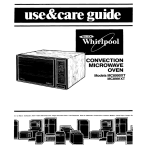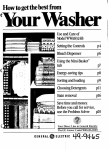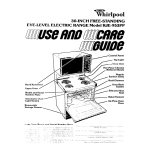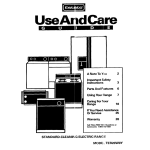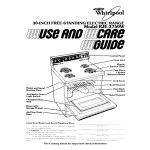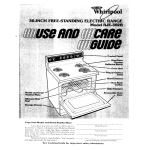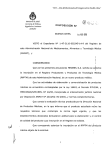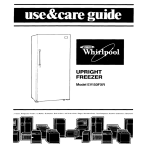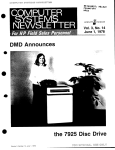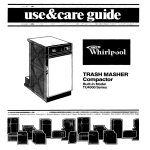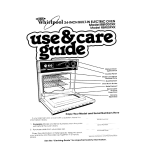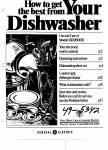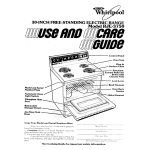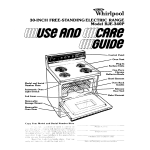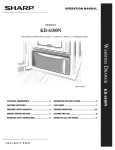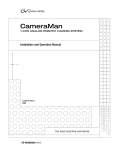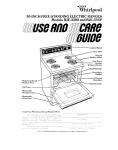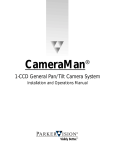Download Whirlpool RIE360B User's Manual
Transcript
TF&3001 30-INCHFREE-STANDINGUECTRICRANGE ModelRIE360B Control Panel Chrome Model and Serial Number Plate Automatic Oven Light Switch Storage Drawer Oven Signal Light Oven Temperature Table Control Lock Light Knob Clean Light Oven Selector of Contents BEFORE USING YOUR RANGE USING THE SURFACE UNIT CONTROLS USING THE OVEN CONTROLS l Baking l Broiling ,,,. l Vanable Broil Fracture l Resetting the OLcanTemperature Control Knob SETTING THE CLOCK TO THE CORRECT TIME OF DAY. USING THE MINUTE TIMER USING THE AUTOMATIC MEALTIMER. CLOCK OVEN RACK POSITIONS USING THE OVEN LIGHT THE OVEN VENT THE OPTIONAL ROTISSERIE USING THE SELF-CLEANING OVEN. CLEANING AND CARING FOR YOUR RANGE,. l Removing and Replacing Control Knobs l Cleaning Under the Cooktop l Removing the Storage Drawer l Cleaning Chart IF YOU NEED SERVICE OR HELP 1. BeforeYouCallforService .:I::::::,‘.:::: 2. If You Need Service 3. If You Have a Problem : : 1: : : : : : : 1 : 1 : 1: 111 : Knob Surface Unit Signal Light Surface Unit Control Clock Minute Knobs Before using Stop Time Knob Timer Start Time Knob your range IMPORTANT This is the only fine pnnt you’ll find in this booklet. Please read it to be sure you use your range as it was meant to be used. We build appliances to last. but we can’t control how they are used. Before using it. you are personally responsible for making sure that it.. l is properly installed and leveled on a floor that will hold the weight. and in a well-ventilated room l is connected only to the right kind of outlet. with the right electric supply and grounding. l IS used only for lobs expected of home ranges. l is out of the weather l IS properly maintained. l is not used by childrc)n or others who may not understand how it should be used 3 Using the surface unit controls The Surface Unit Control Knobs must be pushed In before turning them. This helps avoid turning them on accidentally when wiping off the Control Panel. And it helps keep small children from turning them on. You must PUSH IN and turn to setting. push in on them...then turn to the setting you want. A design by each knob tells which unit is turned on by that knob. (For example. [ . ] shows that the right front unit.. the one closest to you on your right.. will heat when you push in and turn that knob.) The knob may be set anywhere between “HI” and “OFF.” As you use your surface units. you will get used to the settings that match your pots. pans and favorite foods the best. As a guide. the setting should cook at about the following heats: HI - To start most foods cooking. To bring water to a boil. MED-HI -To hold a rapld boil; to fry pancakes or chicken. MED ~ To make gravy. puddings and icings; to cook large quantities of vegetables. MED-LO ~ To keep food cooking after starting it at a higher setting. LO -~ To keep food warm until ready to serve. You will notice that you can set the heat higher or lower within the LO band [ Lo] to help keep food at the temperature you want. The Signal Light will glow whenever a Surface sure this light is off when you have finished cooking. Using Unit is on. Be the oven controls Baking: First-Follow the directions on page X for “Positioning Oven Racks.” To bake, turn the Oven Selector Knob to BAKE. Second--Turn the Oven Selector Knob to “BAKE.” Third-Turn the Oven Temperature Control Knob to the baking temperature you want. The Oven Signal Light will glow while the oven is heating. When this light goes off, the oven has heated to the temperature you set. Fourth-Place food in oven. The heating elements turn off and on during baking to keep the oven at the temperature you set. The Oven Signal Light will glow when the heating elements are on. Fifth--When the baking is done, turn both the Oven Temperature and Oven Selector Knobs to “OFF.” NOTE: Do not lock the oven door during baking. If you do, you may not be able to unlock it until the oven has cooled Broiling: To broil, turn the Oven Selector Knob to BROIL. First-Follow the directions on page 5 for placing meat at the right distance from the Broil Element. Second-Turn the Oven Selector to “BROIL.” Third-Turn the Oven Temperature Control Knob to “BROIL” or turn it to a lower temperature (see “Variable Broil Feature.“ below). Fourth-Put the broiler pan on the oven rack. Fifth-Keep the oven door open about four inches (10 cm). There is a stop in the hinges to hold it there. The Oven Signal Light will glow while the broil element is on. Sixth-When you are through. turn both the Oven Temperature Control and the Oven Selector Knobs to “OFF.” The following chart suggests broiling times and oven-rack positions for different kinds of meats when the Oven Selector Knob is set to BROIL. Inches (cm) from Food ALWAYS broil with the door open about 4 inches (10 cm). Beef Steaks Rare Medium Well done Beef Steaks Rare Medium Well done Hamburgers Lamb Chops Medium Ham slice. precooked or tendered Canadian Bacon Pork Rib or Loln Chop Well done Chlcken Fish Liver Description top of food to Broil Element Approximate Minutes 2nd side 1st side l”12 5cm) I” (2 5 cm) 1” (2 5 cm) 3” (8 cm) 3” (8 cm) 3” (3 cm) 7-9 9-11 1 l-l:3 3-5 4-7 5-7 l’~‘(4cml 1’2” (4 cm) l’i”l4cm) ‘2” (1 cm1 4”-5”(1@13cm) 4”-5”(1&13cm) 4”-5”(10-13 cm) 3” (8 cm) 13-15 17-19 19-21 6-S 6-X S-10 14-16 4-S 1” (2 5 cm) I i “- 1 ” 3” (8 cmi 6-S 4-5 II-2 5cml ‘2” (1 cm1 $4 -1” 12-2 5 cm1 2-3 lb 11-1 5 kg) cut In half whole fillets ’ 2” i4” 1l-2 cm) 3” (8 cml 3” (8 cm) 6-H 6 4-5 4 Frankfurters screw; NOTICE position of notches. Lower: move black part toward “LO.” One notch equals about 10°F (5°C). Higher: move black part toward “HI.” One notch equals about 10°F (5°C). Variable 3” 5’ (10-13 cm) 7” -9” (1X-23 cm) 3” (8 cm) 3” (8 cmi 3” (8 cm) 4”-5”(1&13cm) 15 10 25-K 11-16 7-x IO-12 9-14 s-7 3 6-7 3 4-5 Broil Feature: You might want to broil some foods slower than others. Brolllng can be slowed down by setting a lower temperature on the Oven Temperature Control Knob instead of “BROIL.” Using a lower temperature will cause the broil element to turn on and off during the broiling so that the food broils more slowly. When the Oven Temperature Control Knob is on “BROIL.” the Broil Element heats all the time Set the temperature lower and it heats some of the time. The lower the temperature setting. the shorter are the periods of heating. NOTE: The Oven Selector must be in the “BROIL” posltion In order for the Broil Element to heat. Resetting the Oven Temperature Control Knob: Does your new oven seem hotter or colder than your old oven? The temperatures in older ovens often shift very gradually. getting hotter or colder without the user really noticing the change. Your new oven is properly adjusted to provide accurate temperatures. but when compared to your old range, the new design may give you different baking results If you think that the temperature setting on your range needs to be hotter or colder, you can adjust the Temperature Control Knob by yourself. To adjust the setting, first pull the Oven Temperature Control Knob straight off. On the back. just across from the locking screw, are a row of notches on the black part of the knob and one tooth on the chrome part. To set your oven about lO”F(5”C) cooler, remove the locking screw and move the row of notches one notch closer to “LO.” To set your oven about lO”F(5’C) warmer. move the row of notches one notch closer to “HI.” Each notch equals about lO”F(5”C). Replace the locking screw. 5 Setting Clock and Timer Knob the clock to the correct time of day 1 Push in the Minute Timer Knob and turn it clockwise to set the hands to the correct time of day. 2 The Minute Timer hand will turn as you set the clock. When the clock is set. let the knob pop out. Then. while it is out. turn the Minute Timer hand clockwise to “OFF.” If you push in on the knob when setting the Minute Timer. you will change the setting of the clock. Using the Minute Timer The small numbers inside the clock face are the minute markings. Turn the knob in the center of the clock...don’t push it in. ..to the number of minutes you want to time. When the time you set is up. a buzzer will sound. Turn the hand to “OFF” to stop the buzzer. The Minute Timer does not start or stop cooking. It only buzzes when the time you set is up. It can be used to time almost any cooking operation. It can even remind you of other thmgs (like when to add the softener to the washer) For the most accurate timing. turn the knob past the time you ulant. Then turn it bac.k to the setting. Minute Timer Using the automatic MEALTIMER’ clock The automatic feature of the MEALTIMER< Clock lets you be away from home when the oven starts. or when it stops. It will turn on and off automatically. or lust turn off automatically. Let’s say you tlave a roast that will take four hours to cook. Dinner is supposed to be at (1.00. but you have an appointment at 1.30 and you know you won’t get llome until at least 4.00. When do you have time to put in the roast’! With the Autornatlc MEALTIMER’ Clock, it’s easy. Just before you leave lor your appointment. put the roast in the oven. set the start time for 2:OO and the stop time for 6:OO (four hours). Set the Oven Selector to “TIMED” and set the Oven Temperature Control Knob for the temperature you want. Then leave. The oven will start at 200. bake for four hours at the selected temperature. and shut off at 6:O0. .Tmk To start and stop your oven automatically: 1. Be sure the clock is set to the right time of day. (The start and stop time hands will also show the correct time.) 2. Place the food in the oven. 3. Push in and turn the Time Knob clockwise time you want start. the Start to the oven to 5. Turn the Oven Temperature Control Knob to the temperature you want to use to cook the food. When cooking is finished, 4. Push in and turn the Stop Time Knob clockwise to the time stop. 6. Set you the want Oven the oven Selector to to “TIMED.” turn both the Oven Selector and the Oven Temperature Control Knobs to “OFF.” If you want to stop the oven before it stops automatically, turn the Temperature anti Selector Knobs to “OFF.” Remove food from the oven. You don‘t have to do anything wtth the Stop Time Knob. When you want the oven to start now, but stop automatically: 1 Be sure the clock ,-lnd the start and stop time hands show the right time of day 2 Put the fr,od III thr, oven 3. Push in and turn tihe Stop Time Knob to the time you want the oven to stop cookq 4 Turn the Oven Sc,lector to “TIMED” and the Oven Temperature Control to the temper<lture setting you want. 5 When cooking IS ,rnished. turn the Oven Selector and Temperature Control Knobs to ‘.OFF Oven rack positions Your oven has two racks. Always put the racks where you want them to be before you turn on the oven. To remove a rack. take hold of it on the front edge and pull it out until it stops. Then lift up the front edge and pull again. It will slide past the stops. out of the guides and out of the oven. To put it back, fit the back corners into the guides at each side of the oven and slide it in. keeping the front tilted up until the rack passes the stops in the rack guides. To remove rack, pull forward until rack stops, lift and pull. For: Place Rack: Baking On the second or third rack guide from the top.. so food is in the center of the oven. So food is about the distance from the broil element suggested in the broiling ttmetable under “Using the Oven Controls.” On the bottom rack guides. Broiling Roasting LARGE cuts of meat Roasting SMALLER cuts of meat ~___ So food is in the center of the oven. When baking, always leave at least 1% to 2 inches (4-5 cm) of air space between the sides of a pan and other pans and the oven wall for air circulation. Gasket 1 0 B @E 0 To replace the oven light, remove glass cover and gasket. For best results. get additional information on placing pans. cookte sheets and other utensils from the “Cooking Guide.” Using the oven light The Oven Ltght will come on when the Oven Door IS opened. To replace the light bulb: The oven light bulb has a glass cover which is held on by a wtre holder. This cover must be in place when the oven is being used. 1. Turn off the electric power at the main power supply. 2. Pull out on the wire holder and move it to one side. This will let you remove the glass cover and gasket. 3. Replace the bulb with a 40-watt appliance bulb (designed to stand up to oven heat) available at most grocery, variety and hardware stores 4. Replace the gasket and glass cover. Snap the wire holder in place. The oven vent There is an oven vent under the right rear surface element. When the oven is on. heated air will escape through it. A vent is needed for air circulation in the oven during baking. You can cook on this surface unit while the oven is on. A warm pan of food will stay warm on this unit while the oven IS on. It may be warm enough to melt butter. too. Do not try to save heat or energy by blocking the vent. Poor baking can result. Plastic utensils may melt if they are over the vent while the oven is on. The optional rotisserie If you would like a rotisserie with your oven. you can order a kit from your dealer. Easy installation instructions come with the kit. Usins the self-cleaning oven cycle The Self-Cleaning Oven uses high heat that actually burns away oven soil. For best results and safety, read this section carefully. Make sure you understand how everything works before you set your oven to “CLEAN.” Things l l l l l l l l to do before you start: Some areas may not be cleaned during the Self-Cleaning cycle: -The frame around the oven opening -The door. especially the part around the outside of the oven seal. Soil on these areas will be more difficult to remove after the SelfCleaning cycle. Use hot water and detergent.. or a soapy steel-wool pad. Rinse well. Do not move or bend the fiberglass clean it by hand. oven door seal. Do not try to The high heat during the cleaning cycle will discolor the racks and take the shine off them if they are left in the oven during the SelfCleaning cycle. If you want your oven racks to stay shiny and bright, take them out before starting the cleaning cycle. If you do clean the racks during the cleaning cycle. read the “Special Tips” at the end of this section. Don’t leave any pots or pans in the oven during cleaning. They won’t be able to stand the high heat. Wipe up spillovers. boilovers and grease that hasn’t baked onto the bottom of the oven. This will help reduce smoking during the cleaning cycle. Chrome reflector bowls must not be cleaned in the oven. Turn on the vent hood fan or other kitchen vents during the cleaning cycle. This will help remove smoke. odor and heat that are normal during the cycle If you have a rotisserie, be sure the motor socket cover is closed. 9 Setting the controls 1. Set the Oven to “CLEAN.” 10 to the Self-Cleaning Selector Knob cycle: 2. Set the Oven Temperature Control Knob to “CLEAN.” 3. The clock and dials for start and stop time should all have the right time of day. 4. Push in on the Stop Time Knob and set it ahead as many hours as you want for the cleaning cycle. For a lightly soiled oven, two hours ahead may be enough. For heavy soil, three hours ahead may be about right. If some soil does not get removed during the cleaning cycle, see “Special Tips” later in this section. 5. Lock the oven door by moving the Lock Lever all the way to the right. When it is all the way over, the Clean Light will come on. If the Clean Light doesn’t come on, the lever isn’t all the way over and the cleaning cycle won’t start. When the clean light comes on, the oven starts the cleaning cycle. About 20 minutes later, the Lock Light will come on. It will stay on during the cleaning cycle. The door cannot be unlocked while the Lock Light is on. 6. The oven will shut off when the preset stop time is reached, but the oven door will stay locked until the oven has cooled. When the Lock Light turns off, turn the Oven Selector Knob and Oven Temperature Control Knob to “OFF.” This turns off the Clean Light. Now, move the Lock Lever back to the left. Do notforce the Lock Lever. If it doesn’t want to move easily, wait until it does. With the Lock Lever all the way to the left, the oven door can be opened. 7. When the oven has cooled off a11 the way. wipe out any residue or ashes from the bottom. How the Self-Cleaning cycle work s: When oven contr& are set to “CLEAN.” the oven gets much hotter than it does for cooking. This high heat causes soil on the inside oven walls to burn off, or break up and mostly disappear. While this is happening. a special part in the oven vent helps remove smoke. DO not cover the right-rear surface unit during the cleaning cycle. The chart below shows about what happens during a 2-hour SelfCleaning cycle. Any time less than that shortens only the cleaning cycle. not the heating and cooling times. Don’t touch the range during the cleaning cycle.. it will be hot. When the cleantng cycle is over. you will find some fine ashes in the oven The amount of ash depends upon the amount of soil there was in tile oven. When the oven is cool, clean up all that is left with a damp cloth, cleanser. or a soap-filled steel-wool pad. During the cleaning cycle. you may hear the sounds of metal heating and cooling. These are normal sounds. and a lot like those you can hear when the oL,en heats for regular cooking. SELF-CLEAN OVEN-LIGHT SOIL CYCLE 1000 1000. 800 800. 600 600” 400 400 200 200; 1 hr. 1 Yz hr. 2 hr. 2Yz hr. 11 Special l l l l l l l tips: If the cleaning cycle doesn’t get the oven as clean as it should be, the time set for cleaning was probably not long enough. Set the cleaning time longer next time. You can set it for more than 3 hours. if you want. Plan to clean the oven before it gets too heavily soiled. Otherwise. you may notice more smoke than you would expect coming from the oven vent. And. the cleaning cycle has to be longer to clean a very soiled oven There will be normal “heat odors“ during the cleaning cycle. To help get rid of them. keep the kitchen well ventilated. To stop the cleaning cycle after it has started: -Turn the Stop Time Knob to the right time of day. --Turn the Oven Selector Knob to “OFF.” --Turn the Oven Temperature Control Knob to “OFF.” --.-Unlock and open the oven door when the Lock Light turns off NOTE: Do not force the Lock Lever. Wait until it moves easily. Do not use foil or other oven liners in your Self-Cleaning Oven. Don-t use commercial oven cleaners in your Self-Cleaning Oven. If racks are left in the oven during a cleaning cycle. they will lose their shine. discolor and be harder to slide in and out. To make them slide easiclr. polish the edges of the racks and rack guides with a soapfilled steel wool pad. rinse well. and wipe on a thin coating of s&d oil Cleaning and caring for your range Your range is designed to be easy to clean. You will usually wipe off spills and spatters when they happen. but you will sometimes want to clean under and behlnd the control knobs and surface units. This section will tell you how to remove those. and what to use when cleaning. Removing 1, 2. 3. 4. 5. and replacing surface unit control knobs: Be sure the control knobs are set to “OFF.” Pull straight out on the black knobs. If the control has a chrome trim ring. pull it straight out. Wash the knobs (and trim rings) in warm. sudsy water. Replace the trim rings first. If the control spring was removed, it back exactly as shown on the left...smaII put end first. 6. Hold the black knob so it points to “OFF” Push it straight back on. Removing Pull knob and trim ring straight out. Remember how the spring goes. 12 and replacing oven control knobs: 1. Be sure the knobs are set to “OFF.” 2. Pull each knob straight off. 1% Wash the knobs In warm, sudsy water. 4. The knobs are not interchangeable. Make sure you put the adjustable Oven Temperature Control Knob on the right place. and the nonadjustable Oven Selector Knob on the other. I ,\ Removing Terminal surface wash surface mal use. To remove surface unit, lift and pull straight out. units and reflector bowls: 1. First. be sure the Surface Unit Controls are all “OFF” and that the surface units are cool. 2. See where the surface units plug into the range? Lift each surface unit about an inch (2.5 cm) at the edge away from the plug-in (receptacle). Pull the unit straight away from the plug-in. Do not units: they will burn themselves clean during nor- 3 Lift out the reflector bowls. Hold surface unit level when replacing. Replacins reflector bowls and surface units: Be s’;re the surface unit controls are on “OFF” Put the reflector bowls back into their places. Make sure you can see the plug-ins (receptacles) for the surface units through the square hole in the side of each bowl. Hold the surfact> unit level with the prongs (terminals) pointing at the plug-in With the prongs <tarted In the plug-in. start pushing in on the surface unit. At the same time. lift a little on the side of the surface unit that’s by the plug-ill 5. Make sure the sul-face-unit prongs are pushed into the plug-in as far as they will go. The surface unit will fit into the reflector bowl and be level when everything has been done right. Cleaning Prop up the top with support rod. Removing Pull to stop. Lift; pull again. under the cooktop: To clean the area under the cooktop. lift the front of the cooktop at the center. Raise the swing-up rod to hold it. (Be sure the tip of the rod is in the notch in the cooktop.) Use warm soapy water and asponge or cloth. Scouring powders or any other abrasive cleaner may harm porcelainenamel finishes and can scratch chrome. Be careful not to raise the cooktop so high that it touches the control console. And don’t drop it Dropping the cooktop can chip or crack a hard porcelain finish. or damage side panels and surface units. the storage drawer: The drawer below your oven is meant to store pots and pans. Never keep anything in there that will burn or melt. You may want to remove the drawer for cleaning under the range. Pull it straight out until It stops. Lift the front and pull some more to get it over the stop. Now slide it out until it stops again. Lift the drawer away from the range until it slops out of the guides. To put it back. fit the side rails at the back of the drawer into both guides on the range Fush it closed while lifting the front to get past the stops. 13 PART WHAT TO USE HOW TO CLEAN Outside of appliance Soft cloth, warm soapy water l Nylon or plastic scouring pad for stubborn spots Surface units l No cleaning required Warm. sudsy water and bnstle brush Chrome reflector bowls Automattc dishwasher or warm, soapy water or plastic scrubbing pad Do not allow food containing acids (such as vrnegar. tomato. lemon juice or milk) to remain on surface. Acids will remove the glossy finish. l Do not use abrasive or harsh cleansers l Spatters or spills will burn off. l Control knobs and chrome nms Wipe off regularly when range is cool. Wipe off excessive spills with damp cloth when surface unit is cold. Do not place in Self-Cleaning Oven. l Do not immerse in water l Wash. rinse and dry well. l Do not soak. l Clean frequently. l Wash with other cooking utensils. l I)o not use harsh abrasives l Wash with other cooking utensils. l Do not place in Self-Cleaning Oven. Aluminum broiler pan and grid Warm. soapy water or soapy steel wool pads Control panel Warm. soapy water l Wash, rinse and dry with soft cloth. Oven racks Self-Cleaning Oven cycle l Leave in oven during Self-Cleaning cycle Warm. soapy water or soapy steel wool pads Oven door glass Self-Cleaning Oven l Wash. rinse and dry. Use soapy steel wool pads for stubborn areas. Make certain oven is cool. Wash. rinse and dry well with soft cloth. Warm. soapy water or plastic scrubbing pad l Commercial glass cleaner l For areas outside SelfCleaning area use warm. soapy water or soapy steel wool pads . Clean before using Self-Cleaning cycle to prevent burnon of soil. l l Follow directions provided with cleaner. Follow directtons grven on page 9. “Using the Self-Cleaning Oven Cycle.” Do not use commercial oven cleaners. Do not use foil to line the bottom 14 of your Self-Cleaning Oven. If you need service three steps: or help, we suggest you follow these 1. Before you call for service^: If your range does not seem to be operating properly. check the following before calling for service. If nothing l l operates: Is the range plugged into an operating outlet or wired into a live circuit with the proper voltage! (See Installation Instructions.) Have you checkt>d the main fuse or circuit-breaker box? If the oven will not operate: l l Is the Oven Selector Knob turned to a setting (BAKE or BROIL. but not TIMED)” Is the Oven Temperature Control Knob turned to a temperature setting’? If surface l l l units will not operate: Have you checked the main fuse or circuit-breaker box? Are surface units plugged in all the way? Do the control knobs turn? If surface-unit l l Control If the Self-Cleaning l l l l Knob or Knobs will not turn: Is the spring put in correctly. as shown on page 12 in the “Cleaning and Canny for your Range” Section? Did you push in before trying to turn? Cycle will not operate: Are the Oven Selector Knob and Oven Temperature Control Knob set to “CLEAN” ’ Does the Start T:jne Knob show the correct time of day? Is thk>Stop Tim<’ Knob set ahead to the time you want the cleaning cycle to stop” Is the Lock Lc,vt,, Jl the way to the right? (The Clean Light will come 011) If cooking results aren’t what you expect: Is the range level’ l Are you using paris recommended in the Cooking Guide? l If baking. have you allowed 1’ 2 to 2 Inches (4-5 cm) on all sides of the pans for air circulation! l Does the oven temperature seem too low or too high? See page 5. “Resetting Your Oven Temperature Control Knob.” l Have you preheated the oven as the recipe calls for? l Are the pans the 5ize called for in the recipe? l Are you following a tested recipe from a reliable source? l Do the cooking utensils have smooth. flat bottoms? l Do the cooking utensils fit the surface unit being used? See the Cooking Guide for more information on cooking problems and how to solve them 2. If you need service. : If your WHIRL,POOL’ appliance ever needs service anywhere in the United States. help is lust a phone call away to your nearest Whirlpool franchised TECH-CARE’ service representative. Whirlpool maintains a nationwide network of franchised TECH-CARE service companies to fulfill your warranty and provide afterwarranty seTvIce and maintenance to keep your WHIRLPOOL appliance in peak condition. l 15 You’ll find your nearest TECH-CARE service company listed in your local telephone book Yellow Pages under WashersiDryers-Repairing or Servicing. Should you not find a listing, dial free, the Whirlpool COOL-LINE” service When calling from: Michigan .. Alaska & Hawaii assistance ... . telephone ., . . number .. . .. (800) 253-1301. (800) 632-2243 (800) 253-1211 If you move.. To make sure that your appliance is correctly installed and to insure its continued satisfactory operation, please telephone your nearest TECH-CARE” service company for installation or to get the name of a qualified installer. (Installation cost will. of course, be paid by you.) Helpful hints.. You can help your TECH-CARE service representative give you faster service if you include the model and serial number of your appliance ushen requesting service Also. retain your sales slip and warranty to verify your warranty status Remember.. Your TECH-CARE service representative is specially trained in the expert repairing and servicing of your WHIRLPOOL appliances. He can help you maintain the quality originally built into your WHlRLPOOL appliance. So why riot take the time. now. to look up his telephone number and jot it down 111the space provided on the cover. 3. If you have a problem’: Call Whirlpool Corporation in Benton Harbor at the COOL-LINE service assistance telephone number (see Step 2) or write: Mr Strph~~n t: Upto: 1.Vice President Whirlpool Corporatic> Administrative Centc,; 2000 U.S. 33 North Benton Harbor. Mlchlyar> 49022 If you must call or write. please provide: your name. address. telephone number. type of appliance. brand. model. serial number. date of purchase. the dealer‘s name. and a complete description of the problem. This informatior! IS needed in order to better respond to your request for assistance mirlpool cc k”“. Part No 310602 .YTi I tle111o11 Harbor, Mlchlgan Auromatac Washers. Clothes Dryers, Freezers Refrigerator Freezers, Ice Makers, Dishwashers, Bud1 I” Ovens and Surface Umts, Ranges. Microwave Ovens, Compactors, Room AK Condltmners. Dehumldlflers. Central Heailng and Au Condltmmng Systems Pnnted ,,I U S A
















